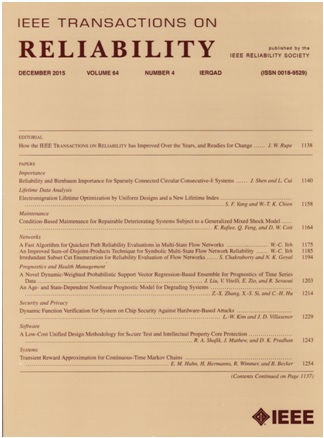利用自组织映射和模型平均估计固态硬盘的平均故障时间
IF 5.7
2区 计算机科学
Q1 COMPUTER SCIENCE, HARDWARE & ARCHITECTURE
引用次数: 0
摘要
本文提出了一种两步法来估计固态硬盘(SSD)的平均故障时间(MTTF),首先通过多通道信号融合制定一个复合健康指标,然后进一步预测退化模型错误规范下的剩余使用寿命(RUL)。具体来说,构造了一个基于自组织映射的无监督神经网络来近似多变量监测属性与单变量SSD健康指标之间的高度非线性关系。对于每个SSD,通过平滑技术进一步校准随时间变化的复合健康指标,并将其制定为具有统一故障阈值的通用路径退化模型。通过外推每个退化路径以达到故障阈值,得到ssd的rul作为假故障时间,并通过各种寿命分布拟合。最后,提出了一种新的模型平均策略,对候选退化模型和寿命分布的多种组合估计的mttf进行加权,以减轻模型错配的影响。一个真实的SSD数据集被用来证明所提出的两步方法的可行性。数值结果表明,该方法能较好地表征不同模型假设和设置下的潜在退化过程。本文章由计算机程序翻译,如有差异,请以英文原文为准。
Estimating Mean Time to Failure of Solid-State Drives via Self-Organizing Map and Model Averaging
In this article, a two-step approach is developed to estimate mean time to failure (MTTF) of solid-state drives (SSD) by first formulating a composite health indicator via multichannel signal fusion and further predicting the remaining useful life(RUL) under degradation model misspecification. Specifically, an unsupervised neural network based on self-organizing map is constructed to approximate the highly nonlinear relationship between multivariate monitoring attributes and a univariate SSD health indicator. For each SSD, the composite health indicator over time is further calibrated by smoothing techniques and formulated into a general path degradation model with a uniform failure threshold. By extrapolating each degradation path to hit the failure threshold, the RULs of SSDs are obtained as pseudofailure times, which are fitted by various lifetime distributions. Finally, a novel model averaging strategy is proposed to weigh the MTTFs estimated by multiple combinations of candidate degradation models and lifetime distributions to alleviate the impact of model misspecification. A real-world SSD dataset is used to demonstrate the feasibility of the proposed two-step approach. Numerical results suggest that the proposed approach better characterizes the underlying degradation process under different model assumptions and settings.
求助全文
通过发布文献求助,成功后即可免费获取论文全文。
去求助
来源期刊

IEEE Transactions on Reliability
工程技术-工程:电子与电气
CiteScore
12.20
自引率
8.50%
发文量
153
审稿时长
7.5 months
期刊介绍:
IEEE Transactions on Reliability is a refereed journal for the reliability and allied disciplines including, but not limited to, maintainability, physics of failure, life testing, prognostics, design and manufacture for reliability, reliability for systems of systems, network availability, mission success, warranty, safety, and various measures of effectiveness. Topics eligible for publication range from hardware to software, from materials to systems, from consumer and industrial devices to manufacturing plants, from individual items to networks, from techniques for making things better to ways of predicting and measuring behavior in the field. As an engineering subject that supports new and existing technologies, we constantly expand into new areas of the assurance sciences.
 求助内容:
求助内容: 应助结果提醒方式:
应助结果提醒方式:


